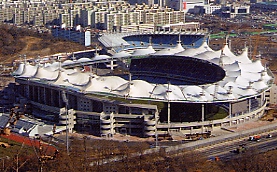 |
| Posters | Videos | CD-ROMS | Games | Soccer Mags | Books | Products! |
 |
| INCHEON |
| Korea's Logistics and Information
Hub for the 21st Century |
Incheon is Korea's second largest port and fourth largest city with a population of 2.5 million people.
Situated on the west coast of the Korean Peninsula, Incheon is best known to history as the place from which General Douglas MacArthur launched the counterattack that changed the course of the Korean War. However, Incheon has historically been a much more peaceable gateway to Korea.
The city's proximity to China has always guaranteed Incheon's status as one of Korea's most important trading hubs. The strength of Incheon's relationship with Korea's much larger neighbour can be still be seen today - Incheon is home to the largest Chinatown in Korea.
Incheon's strength as a strategic port was recognised by the western powers in 19th Century, when repeated delegations arrived from the United States, Great Britain and France demanding that it be opened to foreign trade. Today, Incheon is not only open to foreign trade - it is probably the most important logistics centre in Korea.
Incheon became the official international gateway to Korea on March 29, 2001, when the brand new, Incheon International Airport opened. This state of the art transportation facility is already the world's second largest air cargo hub and aspires to become the transportation hub for the whole of Northeast Asia. It faces stiff competition from neighbouring airports. However, with more than 40 cities with populations of one million or more within three hours flying time of Incheon, the city may soon rise to be one of the most prominent logistics hubs in the world.
Incheon has an even greater importance to Korean football. In 1882, children from Incheon began imitating the crew of the British warship H.M.S. Flying Fish, who were amusing themselves by kicking a leather ball around near the ship. The sailors were so taken with the people of Incheon that they left a couple of footballs behind when they departed, making Incheon the place at which modern football was introduced to Korea.
Information
Website: http://worldcup.inpia.net
Tel: 82-32-440-3971~7
Fax: 82-32-429-3614
Source: FIFA
| INCHEON MUNHAK WORLD CUP STADIUM |
 |
| The design of the Incheon stadium recalls the sailboats thatvsymbolise Incheon's historical role as Korea's leading maritime gateway. |
| Key Facts Name: Incheon Munhak Stadium Type: Multi-purpose Open: December 2 2001 Cost: W326.6 billion Total Capacity: 50,256 Spectator seats: Under cover: 49,256 Open: 1,000 VIP seats: 352 VIP Boxes: 61 ( 230 seats) Disabled seats: 306 |
| Pitch Size: 110m x 71m Spectator Parking: 4,559 Distances to Stadium From city centre: 2 km From Incheon International Airport: 40 km From Gimpo Airport: 30 km From subway station: 500 m Press Facilities Press seats: 212 Seats with desk and telephone: 400 Space for commentators: 297 Space for photographers: 100 |
Source: FIFA
 |
 |
 |
 |
 |
 |
| Videos | New Posters | CALENDARS | Books | Magazines |
| VISIT THE WORLD'S LEADING SOCCER MAGAZINE |
| Posters | Videos | Books | Games | Mags | New Products |
| MAIN LINKS** CLUBS (Intl.) COUNTRIES PLAYERS WOMEN YOUTH COLLEGE HIGH SCHOOL SOCCERMALL |
 |
|